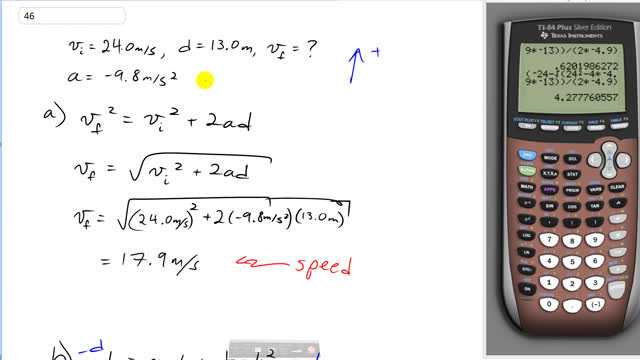
A stone is thrown vertically upward with a speed of 24.0 m/s.
- How fast is it moving when it is at a height of 13.0 m?
- How much time is required to reach this height?
- Why are there two answers to (b)?
- see the picture near the end of the video

In order to watch this solution you need to have a subscription.
This is Giancoli Answers with Mr. Dychko. Let's take up to be the positive direction and we'll write down the information we know; the initial launch speed upwards is 24 meters per second and their question is, what will the speed be when it gets to a height of 13 meters and we know what its acceleration is that due to due gravity which is 9.8 meters per second downwards and so we need a negative sign to reflect that downward direction. So we have this speed formula for in terms of acceleration and distance and initial speed; we'll take the square root of both sides define the final speed and that is 24 meters per second squared initially plus 2 times negative 9.8 meters per second squared and then times 13 meters then we get a speed of 17.9 meters per second. Technically, when you take the square root of both sides, you should have a plus or a minus here and that's true and then this would be a velocity but we are just concerned with the magnitude or the absolute value of this answer and so we'll take its positive. It turns out that it passes its position of 13 meters on the way up and and on the way down and so it's quite true that the velocity is positive 17.9 meters per second on the way up and then negative 17.9 meters per second on the way down. but anyway, the question's asking us for speed and so that's why we have that positive just there as a calculation. And now we'll find the times at which it passes this height of 13 meters and so we have our position formula here; we'll subtract d from both sides to get making this look like a quadratic equation and we'll have d disappear from the left side and then it's minus d on the right and then flip the sides around so we have all the unknown stuff on the left and then it fits our pattern that we'll plug into our quadratic equation here. And we have acceleration negative 9.8, initial velocity is 24—upwards— meters per second and then minus the position of 13 meters above the starting point so that's positive 13 meters but it's a minus because that was introduced by the algebra and so here's what we are going to plug into our calculator. So we have b is the coefficient of the constant term so negative b is negative 24 and then we'll do both plus and minus; plus first of all gives us this version 24 gets squared and then minus 4 times a which is negative 4.9 and then times a c which is negative 13 divided by 2 times negative 4.9 and that gives 0.620 seconds is the first time that it passes this height of 13 meters above where it was launched and then putting a minus sign there in that quadratic equation gives us a second answer of 4.28 seconds after launch, it passes by this height of 13 meters a second time.